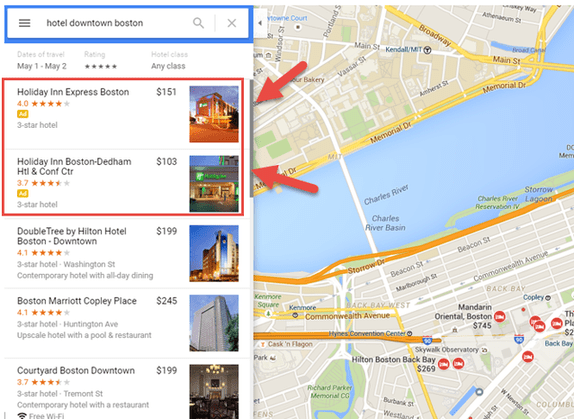Bloomberg’s recent article speculating that Google could make Google Maps a bigger advertising platform, just as Google has done with search in general, has created a stir. On the one hand, the promise of more advertising development on Maps has generated excitement among businesses eager to become more visible on this popular navigation platform. At the same time, the news has triggered some concerns among industry watchers that advertising could become obtrusive. In fact, advertising already happens on Google Maps, and advertising holds promise so long as the ads provide value.
The Worry
As expressed in a recent BGR article, a major concern about advertising on Google Maps centers on the fear that user experience will erode: “Hopefully, Google’s reported interest in leaning on Maps as it hunts for new sources of revenue won’t mean the company goes overboard—like the way you have to scroll down past a slew of ads and highlighted results after conducting a Google Search, for example.”
This is a valid point. No one—including Google—wants to see the user experience on Google Maps become tarnished. Google needs to keep giving users reasons to stay on Google in its many forms. So the company has a strong incentive to monetize Google Maps in a way that keeps the consumer at the center of the experience.
Google appears to be honoring that commitment by exercising caution: Philipp Schindler, Google’s business chief, said at a recent conference that while Google Maps is “a really, really interesting playground [for advertising] going forward,” the basic directions provided by Google Maps are a “utility” that shouldn’t be tampered with. In other words, consumers shouldn’t be bombarded with ads when they are just looking to get from Point A to Point B.
The Reality
If history is any indicator, caution appears to be a feature of the Google Maps playbook. Technically, advertising on Google Maps is nothing new. As Bloomberg points out, “The company has tested ads in Maps for years.” And Google has proceeded thoughtfully all along, keeping the user in mind. Rajas Moonka, the director of product management for Google Maps, notes, “We’ve been pretty careful about not being very aggressive about how we present those to users because we don’t want users to feel like we’re overloading the experience.”
According to The Manifest, Google Maps ads already include features such as:
- Promoted pins. These purple location pins are meant to stand out from the pack of familiar red location pins. When consumers tap on the Promoted Pin, which is paired with the advertising business’s logo, they access more information about the company and its products.
- In-store promotions. A business advertising on Google Maps can show coupons and deals right on their ad.
Promotions are a great example of how an ad on Google Maps can be useful to all parties. If I search for “bookstores near me,” I am probably looking for something to buy—or I’m at least interested in browsing. If a ten-percent-off coupon from a nearby bookstore pops up during my search, I might be convinced to choose that store over another. In other words, a great promotion on Google Maps can turn a casual searcher into a bona fide customer, and prompt a scenario in which both business and consumer are winners.
What’s New Under the Sun
The Bloomberg piece isn’t suggesting that Maps is a new advertising frontier. The question being asked, rather, is are there different and more ways to use the app for advertising? We at True Interactive happen to think that the possibilities are legion. Consider the opportunities afforded if Google Maps advertising became personalized with content sponsored by different companies. In that scenario, a bookstore might serve up a personal ad on your Google Maps app based on your usage of Google Maps, just as already happens on Amazon.com when you get a personalized ad from a company that sells products on Amazon, based on your Amazon search history.
What You Can Do
In short, ads on Google Maps aren’t new, and their evolving services represent an opportunity for both businesses and consumers. We recommend that you:
- Keep track of how Google is transforming itself.
- Track potentially new services/ways to advertise. For example, Google is incorporating augmented reality into maps. You might ask yourself, how can I incorporate augmented reality for both advertising and organic content?
Questions? Contact True Interactive to learn how to advertise on Google Maps and beyond.
